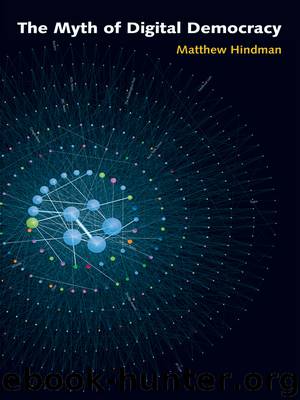The Myth of Digital Democracy by Hindman Matthew

Author:Hindman, Matthew
Language: eng
Format: epub
Publisher: Princeton University Press
Published: 2013-08-25T04:00:00+00:00
Metrics for Concentration
Looking at the market share of the top outlets is not the only way to measure concentration, and social scientists have long relied on more systematic measures to judge the gap between the resource rich and the resource poor. For our purposes, I adapt two of the most broadly used metrics in order to compare concentration across online and off-line media. I also apply a recently proposed metric developed specifically to measure media diversity.
The first of these metrics is the Gini coeffient. Originally developed in the early twentieth century to measure income inequality, Corrado Gini (1921) himself declared that the Gini coefficient could be used to calculate relative inequality for almost any resource. The Gini coefficient is equal to twice the area between the Lorenz curve and the (hypothetical) line of perfect equality.9 There are many ways to calculate the Gini coefficient, but one of the most common formulas is provided by Malcolm Brown (1994). If X is the cumulative proportion of the population, and if Y is the cumulative proportion of the resource in question, the Gini coefficient is equal to the following:
Download
This site does not store any files on its server. We only index and link to content provided by other sites. Please contact the content providers to delete copyright contents if any and email us, we'll remove relevant links or contents immediately.
Algorithms of the Intelligent Web by Haralambos Marmanis;Dmitry Babenko(9831)
Test-Driven Development with Java by Alan Mellor(7635)
Data Augmentation with Python by Duc Haba(7523)
Principles of Data Fabric by Sonia Mezzetta(7292)
Learn Blender Simulations the Right Way by Stephen Pearson(7215)
Microservices with Spring Boot 3 and Spring Cloud by Magnus Larsson(7046)
Jquery UI in Action : Master the concepts Of Jquery UI: A Step By Step Approach by ANMOL GOYAL(6445)
RPA Solution Architect's Handbook by Sachin Sahgal(6444)
The Infinite Retina by Robert Scoble Irena Cronin(6147)
Hadoop in Practice by Alex Holmes(6135)
Big Data Analysis with Python by Ivan Marin(5877)
Life 3.0: Being Human in the Age of Artificial Intelligence by Tegmark Max(5472)
Pretrain Vision and Large Language Models in Python by Emily Webber(4828)
Infrastructure as Code for Beginners by Russ McKendrick(4611)
WordPress Plugin Development Cookbook by Yannick Lefebvre(4330)
Functional Programming in JavaScript by Mantyla Dan(4215)
The Age of Surveillance Capitalism by Shoshana Zuboff(4206)
Embracing Microservices Design by Ovais Mehboob Ahmed Khan Nabil Siddiqui and Timothy Oleson(4102)
Applied Machine Learning for Healthcare and Life Sciences Using AWS by Ujjwal Ratan(4078)
